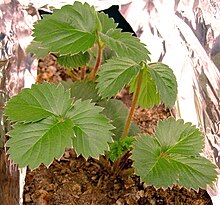Fragaria × vescana
Fragaria x vescana is a species hybrid . The aim of the cross was to combine the characteristics of both parent species - fruit size and yield of the garden strawberry and the aroma of the wild strawberry .
history
As early as the 1920s, attempts were made to increase the yield of cultivated plants by means of polyploidization. In the genus Fragaria, crosses were carried out by Yarnell at Harvard University. He found the first decaploid plants among the seedlings from free flowering of a pentaploid species hybrid from forest and chile strawberries .
In Germany, Rudolf Bauer carried out crossbreeding and polyploidization of various crops at the Max Planck Institute for Breeding Research in Cologne-Volgelsang in the 1950s . With the strawberry, the garden strawberry should be combined with the wild strawberry. The two parent species can be crossed with one another, but the offspring are sterile because the garden strawberry is octoploid and the wild strawberry is diploid . Therefore, as an intermediate step, a hexaploid species hybrid was created from a garden strawberry and a monthly strawberry with a doubled set of chromosomes. This hybrid tends to produce unreduced female gametes , so the egg cells are hexaploid. The fertilization with the tetraploid pollen of the garden strawberry results in decaploid plants.
Vescana varieties
The following varieties come from the Swedish breeding program in Balsgård:
- 'Annelie' (1977)
- 'Sara' (1988) - 'Annelie' × [('Sparkle' × F. vesca 4 ×) free flowering]
- 'Rebecka' (1998) - ('Fern' × F. vesca 4 ×) × F. × ananassa F861502
The following varieties come from Rudolf Bauer's breeding program in Germany:
- 'Spadeka' (1977)
- 'Florika' (1989) - ('Sparkle' × F. vesca 'Semperflorens' 4 ×) × 'Climbing strawberry hummi'
Characteristics of the Vescana varieties
Due to the heterosis, the plants have a tight habit with large, dark green foliage. The inflorescences are erect and often above the foliage. Due to the low tillering, the individual plant only ages a little, so it can get much older than the garden strawberry. Good ground cover is quickly achieved thanks to the strong runners.
The fruits are smaller than those of garden strawberries, they are soft and very aromatic.
Cultivation
The completely different growth type of the Vescana hybrids requires a flat cultivation system. The 'Spadeka' variety, bred for commercial cultivation, was raised like a meadow and harvested mechanically. The fruits have been processed.
The newer variety 'Florika' was tested in self-picking facilities and offered for private gardens. Due to the good ground cover and the low susceptibility to disease, no plant protection is required.
proof
- ^ SH Yarnell: Genetic and cytological studies on Fragaria . In: Genetics. 16 (5) 1931, pp. 422-454, PMC 1201111 (free full text).
- ↑ Anneliese Bauer, Breitbrunn am Chiemsee: Progress in breeding decaploid Fragaria × vescana. In: International Society for Horticultural Science (Ed.). II International Strawberry Symposium. 1992 ( Acta Horticulturae . 348), pp. 60-64 ( [1] ).
- ^ Karin Trajkovski: Rebecka, a day-neutral Fragaria x vescana variety from Balsgård. In: International Society for Horticultural Science (Ed.). IV International Strawberry Symposium. 2000 ( Acta Horticulturae . 567), pp. 177-178 ( [2] ).
- ^ Gertrud Spiegler, Birgid Schlindwein and Herrmann Schimmelpfeng: Studies on the selection of decaploid Fragaria x vescana. In: Commercial fruit growing. 28 1986, pp. 220-221.
- ^ Edelgard Hoberg, D. Ulrich and Herrmann Schimmelpfeng: Flavor quality of a new strawberry population. In: International Society for Horticultural Science (Ed.). Eucarpia symposium on Fruit Breeding and Genetics. 1999 ( Acta Horticulturae . 538), pp. 447-452 ( [3] ).
- ↑ Alois Spitzl, Grabenstätt: Experiences with field-based cultivation of Vescana strawberries in southern Germany. In: Commercial fruit growing. 28 1986, p. 222.
